 Summary
Summary
Despite a few minor complaints, the F10 represents an astonishing achievement. Highly recommended.
| UK Street Price |
£225.00 |
| UK Online Price |
|
| US Online Price |
|
Full Review
It may have won the accolade of European Camera of the Year, but it has to be said that the first impressions of Fujifilm’s compact F10 camera are distinctly underwhelming.
With a clunky, chunky form factor suggesting that the product designer was off sick for the day coupled with a limited set of exposure controls, the F10 looks unlikely to impress holidaying snappers or the tripod-touting cognoscenti.
But lurking inside its bland, all-metal exterior is an astonishing point’n’shoot camera with unique features capable of producing incredible results.
 The camera is the first of a new generation of Fuji cameras sporting the new Super CCD HR sensor which – unlike previous models – doesn’t rely on interpolation jiggerypokery to deliver its 6.3 megapixel output.
The camera is the first of a new generation of Fuji cameras sporting the new Super CCD HR sensor which – unlike previous models – doesn’t rely on interpolation jiggerypokery to deliver its 6.3 megapixel output.
A newly developed ‘Real Photo Processor’ serves up an impressively wide ISO sensitivity range, starting from 80 ISO all the way up to 1600 ISO, allowing flash-free, low light shots and less chance of camera blur.
It’s a snappy performer too, with an ultra nippy start-up time backed up by a claimed 0.01 second shutter lag.
 We can’t count as fast as that, but it certainly proved to be one of the fastest compacts we’ve tested to date, with no perceivable delay after pressing the shutter button.
We can’t count as fast as that, but it certainly proved to be one of the fastest compacts we’ve tested to date, with no perceivable delay after pressing the shutter button.
The camera comes with a 3x optical zoom lens (f2.8 – f5.0 36mm – 108mm, 35mm equiv.) and a large and bright 2.5-inch 115k LCD.
In tests, we found the LCD easy to read in all but the brightest of sunlight although an optical viewfinder would have been a useful addition.
 A handy LCD brightness boost switch helped compose shots in dim light, although we found it prudent to turn off the dazzling, kryptonite-like green focus beam which was so bright that you’d end up with pictures of people covering their eyes and screaming.
A handy LCD brightness boost switch helped compose shots in dim light, although we found it prudent to turn off the dazzling, kryptonite-like green focus beam which was so bright that you’d end up with pictures of people covering their eyes and screaming.
The battery life was hugely impressive. Fuji claim a class-leading 500 shot-per-charge and we certainly had lots of juice left after taking – and enthusiastically previewing – 200+ shots taken around New York.
Essentially a ‘point-and-shoot’ camera, the F10 offers little in the way of real manual control, with just four main modes on offer: scene mode, full auto, manual (auto with limited exposure overrides) and movie mode (VGA, 30 fps, .avi format).
 Out on the streets, the camera proved fast to start up, responsive, quick to focus and produced some excellent quality images, capturing impressively high levels of detail.
Out on the streets, the camera proved fast to start up, responsive, quick to focus and produced some excellent quality images, capturing impressively high levels of detail.
Where the camera really excelled was in low light, with the extended ISO sensitivity allowing natural images to be taken without the use of flash.
Compact cameras generally produce horrendously noisy images when the ISO racks up beyond 200, but Fuji’s Super CCD HR sensor is capable of producing very smooth, detailed images with little noise all the way up to 800.
At 1600 ISO there’s notable evidence of noise and some ‘smoothing’ by the built in noise reduction, but the images are still eminently usable for smaller prints and are leagues above anything the competition can muster – this really is an incredible low-light performer!
 We remained impressed with the camera throughout the testing period, although some gripes surfaced: we found the lack of any real manual control frustrating at times and the less-than-intuitive menu system made some tasks unnecessarily fiddly.
We remained impressed with the camera throughout the testing period, although some gripes surfaced: we found the lack of any real manual control frustrating at times and the less-than-intuitive menu system made some tasks unnecessarily fiddly.
We would have killed for a manual focus mode because without the green beam’o’death, focussing could struggle a bit in low light.
There was also a little more “purple fringing” than we would have liked (thin purple lines around objects in high contrast scenes) and the camera sometimes seemed far too keen to needlessly jump to high ISO sensitivities (but this could be easily fixed by manually setting the ISO rating).
But what we really, really, didn’t like was the plug-in ‘terminal adaptor’ that had to be lugged about to charge the battery or transfer images. Sure, it’s not particularly large, but it’s just another annoyance that could end up being lost or forgotten on a trip.
CONCLUSION
Despite minor complaints, the F10 represents an astonishing achievement; it may not have the slick looks of its rivals or a shed load of fancy-pants, advanced features, but when it comes down to sheer image quality, low light performance, battery life and speed of operation it leaves most – if not all – of the competition standing.
Currently available for around £225 ($385, €330), the Fuji F10 represents excellent value for money. We highly recommend it.
Photographers put off by the lack of manual controls should note that the a new version featuring aperture and shutter-priority modes, the F11, is about to hit the streets.
Features: 65%
Ease of Use: 83%
Image Quality: 87%
Overall: 90%
Fujifilm F10
We’ve recently done a deal with PriceGrabber to offer readers of reviews the chance to buy the reviewed item directly. We will get a small payment each time a link is clicked on.UK Suppliers
US Suppliers
 The long, long, long awaited Mamiya ZD medium format digital SLR is now available on pre-order in Japan, with UK delivery promised in January.
The long, long, long awaited Mamiya ZD medium format digital SLR is now available on pre-order in Japan, with UK delivery promised in January.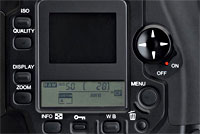 Inside the pixel-guzzling beast lies Mamiya’s exclusive 14bit A/D (analogue to digital) converter, enabling photographers to rattle off 12bit images at a nippy 1.5fps (up to 11 images).
Inside the pixel-guzzling beast lies Mamiya’s exclusive 14bit A/D (analogue to digital) converter, enabling photographers to rattle off 12bit images at a nippy 1.5fps (up to 11 images).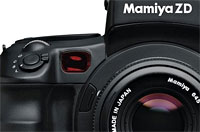 On the back of the camera, a 1.8in LCD offers image previews with a LCD window below displaying ISO and exposure information.
On the back of the camera, a 1.8in LCD offers image previews with a LCD window below displaying ISO and exposure information. The price is going to hover around an eye-watering €9200 – enormous wonga for some, but it’s the kind of figure that may finally tempt die-hard professional film photographers into the digital fold.
The price is going to hover around an eye-watering €9200 – enormous wonga for some, but it’s the kind of figure that may finally tempt die-hard professional film photographers into the digital fold. Vodafone has started to roll out its global Mobile TV channels, serving up a feast of “world-class TV brands, pan-European sports coverage and leading entertainment and documentary programmes”.
Vodafone has started to roll out its global Mobile TV channels, serving up a feast of “world-class TV brands, pan-European sports coverage and leading entertainment and documentary programmes”. Sports fans will be kept amused on the move with Eurosport, UEFA Champions League and, err, Chilli TV (who?) channels, with the Vodafone service also carrying popular channels like MTV and Discovery.
Sports fans will be kept amused on the move with Eurosport, UEFA Champions League and, err, Chilli TV (who?) channels, with the Vodafone service also carrying popular channels like MTV and Discovery.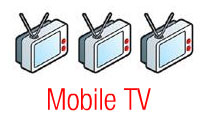 Vodafone say that their research into the market revealed that Mobile TV complemented television viewing habits at home and thus demonstrated a hearty appetite for the product amongst consumers.
Vodafone say that their research into the market revealed that Mobile TV complemented television viewing habits at home and thus demonstrated a hearty appetite for the product amongst consumers.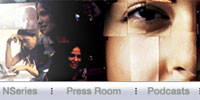 In an attempt to get right on down with the online world, Nokia has unveiled a blog relations campaign for its new N90 phone, offering information and podcasts about the handset to bloggers.
In an attempt to get right on down with the online world, Nokia has unveiled a blog relations campaign for its new N90 phone, offering information and podcasts about the handset to bloggers. “Since bloggers are articulate, passionate, and prolific – and have more space to write in than a newspaper columnist – they can yield incredible dividends,” enthused Abramson.
“Since bloggers are articulate, passionate, and prolific – and have more space to write in than a newspaper columnist – they can yield incredible dividends,” enthused Abramson.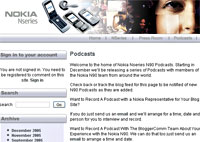 Try as we might, us cynical folks at Digital Lifestyles couldn’t shake off a nagging suspicion that the marketing world’s new-found enthusiasm for blogs is more about trying to control and coerce what’s been written about their products in the blogosphere.
Try as we might, us cynical folks at Digital Lifestyles couldn’t shake off a nagging suspicion that the marketing world’s new-found enthusiasm for blogs is more about trying to control and coerce what’s been written about their products in the blogosphere.  NTL is currently in talks to merge with Virgin Mobile in a deal that would create a potential rival to the now
NTL is currently in talks to merge with Virgin Mobile in a deal that would create a potential rival to the now  In a fiercely competitive market, cable companies on both sides of the Atlantic are looking to outflank their satellite and phone company rivals by adding mobile phone services to their portfolio of voice, Internet and TV services.
In a fiercely competitive market, cable companies on both sides of the Atlantic are looking to outflank their satellite and phone company rivals by adding mobile phone services to their portfolio of voice, Internet and TV services. NTL and Telewest have notched up around 5 million subscribers combined, next to BSkyB’s 7.8 million digital television viewers.
NTL and Telewest have notched up around 5 million subscribers combined, next to BSkyB’s 7.8 million digital television viewers.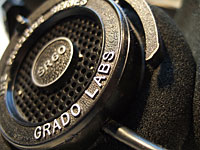 They may look like something a WW2 pilot would have strapped on to their heads before going off for a dogfight, but the Grado SR60s are, quite simply, the best headphones in their price bracket – and higher.
They may look like something a WW2 pilot would have strapped on to their heads before going off for a dogfight, but the Grado SR60s are, quite simply, the best headphones in their price bracket – and higher.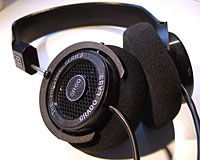 Untroubled by the vagaries of fashion, Grado’s hand-made SR60s have a refreshing no-nonsense look about them.
Untroubled by the vagaries of fashion, Grado’s hand-made SR60s have a refreshing no-nonsense look about them.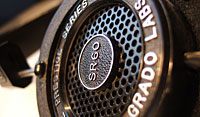 The driver units are covered by black supra-aural foam ear pads, with an unusually thick cable coming from each earpiece, stethoscope-style.
The driver units are covered by black supra-aural foam ear pads, with an unusually thick cable coming from each earpiece, stethoscope-style. Sonically, they’re a revelation. The sound is full-bodied, fast and articulate with a solid bass performance creating an impressively spacious soundstage.
Sonically, they’re a revelation. The sound is full-bodied, fast and articulate with a solid bass performance creating an impressively spacious soundstage. The clarity and depth of these phones is unheard of at this price level – stick on a pair of trendy designer “DJ” headphones after a session on the Grados and it’ll sound like listening to a transistor radio.
The clarity and depth of these phones is unheard of at this price level – stick on a pair of trendy designer “DJ” headphones after a session on the Grados and it’ll sound like listening to a transistor radio. The words European and Commission, when used together rarely equate to clarity. This is holding true with the mixed signals on the financial support that will be permitted in the transition to Digital TV across Europe.
The words European and Commission, when used together rarely equate to clarity. This is holding true with the mixed signals on the financial support that will be permitted in the transition to Digital TV across Europe. The Commission made clear that it supports the transition to digital broadcasting, and that Member States have a variety of methods to assist the digital switchover, that fits in with EC Treaty state aid rules.
The Commission made clear that it supports the transition to digital broadcasting, and that Member States have a variety of methods to assist the digital switchover, that fits in with EC Treaty state aid rules.  Europe could benefit economically and socially, by a concerted approach across Europe to the ‘liberated’ spectrum. The EC wants to see trading in radio wavebands (much championed by the UK regulator OFCOM) and believes that this could assist European firms in launching innovative products and services. A study commissioned by the executive indicated that the move to Digital would have potential benefits of around EUR 9 billion for community members through greater efficiencies.
Europe could benefit economically and socially, by a concerted approach across Europe to the ‘liberated’ spectrum. The EC wants to see trading in radio wavebands (much championed by the UK regulator OFCOM) and believes that this could assist European firms in launching innovative products and services. A study commissioned by the executive indicated that the move to Digital would have potential benefits of around EUR 9 billion for community members through greater efficiencies.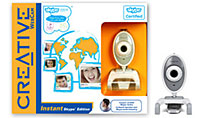 Tying in nicely with Skype’s new video calling feature (Skype 2.0, now in public beta), Creative have announced a new WebCam certified by Skype.
Tying in nicely with Skype’s new video calling feature (Skype 2.0, now in public beta), Creative have announced a new WebCam certified by Skype. “Our partnership with Creative is important in helping to make the consumer experience with Skype Video calling simple and effective,” he continued.
“Our partnership with Creative is important in helping to make the consumer experience with Skype Video calling simple and effective,” he continued.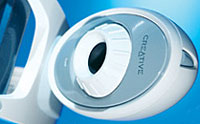 There’s also a ‘snapshot button’ for taking low res stills at 640×480 via interpolation (in other words, it’s a smaller image artificially blown up, so don’t expect anything near digicam quality).
There’s also a ‘snapshot button’ for taking low res stills at 640×480 via interpolation (in other words, it’s a smaller image artificially blown up, so don’t expect anything near digicam quality). Summary
Summary The camera is the first of a new generation of Fuji cameras sporting the new Super CCD HR sensor which – unlike previous models – doesn’t rely on interpolation jiggerypokery to deliver its 6.3 megapixel output.
The camera is the first of a new generation of Fuji cameras sporting the new Super CCD HR sensor which – unlike previous models – doesn’t rely on interpolation jiggerypokery to deliver its 6.3 megapixel output. We can’t count as fast as that, but it certainly proved to be one of the fastest compacts we’ve tested to date, with no perceivable delay after pressing the shutter button.
We can’t count as fast as that, but it certainly proved to be one of the fastest compacts we’ve tested to date, with no perceivable delay after pressing the shutter button. A handy LCD brightness boost switch helped compose shots in dim light, although we found it prudent to turn off the dazzling, kryptonite-like green focus beam which was so bright that you’d end up with pictures of people covering their eyes and screaming.
A handy LCD brightness boost switch helped compose shots in dim light, although we found it prudent to turn off the dazzling, kryptonite-like green focus beam which was so bright that you’d end up with pictures of people covering their eyes and screaming.  Out on the streets, the camera proved fast to start up, responsive, quick to focus and produced some excellent quality images, capturing impressively high levels of detail.
Out on the streets, the camera proved fast to start up, responsive, quick to focus and produced some excellent quality images, capturing impressively high levels of detail. We remained impressed with the camera throughout the testing period, although some gripes surfaced: we found the lack of any real manual control frustrating at times and the less-than-intuitive menu system made some tasks unnecessarily fiddly.
We remained impressed with the camera throughout the testing period, although some gripes surfaced: we found the lack of any real manual control frustrating at times and the less-than-intuitive menu system made some tasks unnecessarily fiddly. Today will see the share IPO of Eutelsat, the third largest satellite operator.
Today will see the share IPO of Eutelsat, the third largest satellite operator. Despite our catastrophic experiences with the
Despite our catastrophic experiences with the 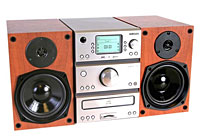 Context-sensitive buttons either side of the display provide a simple user interface offering fast access to relevant features – it’s one of the best interfaces we’ve seen.
Context-sensitive buttons either side of the display provide a simple user interface offering fast access to relevant features – it’s one of the best interfaces we’ve seen. A unique feature to Pure is the ReVu function, which lets you pause and ‘rewind’ live DAB digital radio, courtesy of a constantly updating 20 minute buffer.
A unique feature to Pure is the ReVu function, which lets you pause and ‘rewind’ live DAB digital radio, courtesy of a constantly updating 20 minute buffer.  The package is rounded off by two stylish Rosewood speakers with 5¼” woofers, and 19mm Mylar-dome tweeters, a simple remote control and aerial.
The package is rounded off by two stylish Rosewood speakers with 5¼” woofers, and 19mm Mylar-dome tweeters, a simple remote control and aerial.